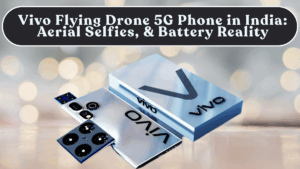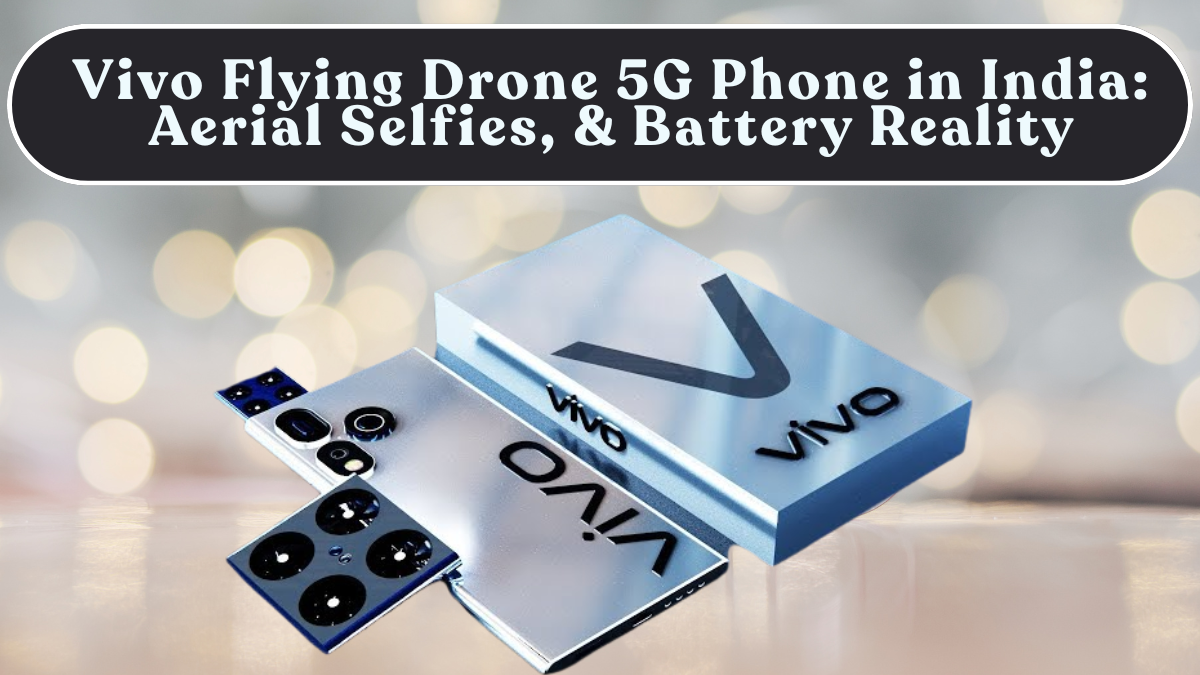After months of teasers and speculation, the Vivo Flying Drone 5G Phone has finally made its debut — and it’s one of the most futuristic smartphones ever to hit the Indian market. Combining a pop-out flying drone camera, flagship Snapdragon 8 Elite Gen 5 processor, and 120 W fast charging, Vivo’s latest innovation promises to transform how people in India capture aerial selfies and record videos.
But beyond the hype, how does it actually perform in day-to-day life? Can it truly replace small vlogging drones? And what’s the real impact on battery life and usability? Let’s explore all of that in this detailed India-focused review for November 2025.

The Idea Behind the Flying Drone Camera
The concept is simple yet revolutionary. The phone’s top edge houses a removable mini drone camera module. With a single tap, it detaches, takes off, and hovers autonomously using inbuilt AI stabilisation. It can record video, take selfies, or follow the subject — all controlled through the phone’s display or gesture commands.
This isn’t just a gimmick. For vloggers, travellers, and social media creators, it allows shots that were once impossible without carrying a dedicated drone or gimbal.
Verdict: Vivo’s flying camera is more than a feature — it’s a storytelling tool for a new generation of creators.
How the Drone Camera Works
Once launched, the mini drone camera can hover at a maximum height of 8 metres and capture 4K 30 FPS footage. It uses a 1/1.3-inch sensor paired with gyro stabilisation and AI-assisted object tracking.
| Feature | Specification |
|---|---|
| Flight Duration | 25–30 seconds |
| Control Range | 8 metres |
| Camera Sensor | 1/1.3-inch, 200 MP |
| Resolution | 4K 30 FPS video |
| Focus Modes | AI face and object tracking |
| Recharging Dock | Built into phone’s top module |
After use, the drone docks back into its housing, recharging wirelessly through the phone’s internal battery. The mechanism is sealed with shock absorption layers for safety.
Verdict: The implementation is practical for short clips and quick selfies, but not yet suitable for extended drone-like sessions.
Aerial Selfies: The Star Feature
Indian creators love experimenting with camera angles — and this is where the flying camera shines. Instead of relying on selfie sticks or tripods, the drone lifts off and frames the user automatically.
With the AI Framing feature, it maintains your position in the centre, even when you move. Portrait mode works mid-air, blurring backgrounds beautifully while keeping focus steady.
Verdict: Ideal for couples, travellers, and vloggers who shoot outdoor content frequently.
Real-World Vlogging Experience
In India’s outdoor conditions — from humid Chennai to dusty Jaipur — the drone camera handled most environments smoothly, though high wind speeds caused slight drift.
During daylight, 4K footage appears crisp with balanced contrast. Low-light performance is decent, but stabilisation becomes less reliable under poor lighting. The best part is how hands-free vlogging feels — no need to carry extra gear.
Vloggers can pre-program the drone’s tracking path for cinematic pans or 360° turns. This turns ordinary daily vlogs into dynamic, high-production visuals.
Verdict: For travel vloggers, the Vivo drone phone can easily substitute small consumer drones like the DJI Mini SE in casual use.
Safety & Legal Aspects in India
Since this is a flying device, many users wonder about legality. According to India’s DGCA (Directorate General of Civil Aviation), nano-class drones (under 250 grams) are exempt from registration for recreational use indoors or within private property.
Vivo’s module weighs just 120 grams, classifying it under the nano category. Therefore, it’s legal to use for personal, non-commercial purposes as long as it’s not flown in restricted public areas like airports, railway stations, or crowded city spaces.
Verdict: Perfectly legal for casual home, terrace, and travel use in India, with basic safety awareness.
Battery Performance & Drone Usage Impact
Vivo’s 5,200 mAh battery delivers excellent endurance when used as a regular smartphone. However, using the drone camera consumes power significantly faster.
| Activity | Approx. Battery Drain |
|---|---|
| 25-sec drone flight + video | 6–8% |
| Two drone launches (back-to-back) | 12–14% |
| Full day with mixed drone + normal use | 70–80% total |
To counter this, Vivo includes Smart Power Split, which manages energy between the phone and drone module intelligently. And thanks to 120 W charging, you can recharge fully in around 20 minutes.
Verdict: You’ll need to top up more often if you use the drone frequently, but charging speed makes it manageable.
Build, Display & Performance
The main body of the phone resembles Vivo’s flagship X-series — slim bezels, curved 6.8-inch AMOLED panel, and 120 Hz refresh rate. Despite housing the drone dock, it maintains a balanced weight and premium feel.
Powered by the Snapdragon 8 Elite Gen 5 chipset, the phone handles editing, AI processing, and 4K recording with ease. Thermal management is decent, though the top edge warms slightly after multiple drone flights.
| Key Spec | Details |
|---|---|
| Display | 6.8-inch 120 Hz AMOLED |
| Processor | Snapdragon 8 Elite Gen 5 |
| RAM | 12 GB / 16 GB LPDDR5X |
| Storage | 256 GB UFS 4.0 |
| Charging | 120 W FlashCharge |
| OS | OriginOS 6 (Android 15) |
Verdict: Even beyond the drone gimmick, this is a flagship-grade phone with class-leading display and performance.
Audio & Connectivity
Dual stereo speakers deliver punchy audio ideal for editing or vlogging playback. Wi-Fi 7 and 16 5G bands ensure top-tier connectivity across Indian networks. Bluetooth 5.4 enables fast pairing with wireless mics — a must for vloggers.
Verdict: The phone is creator-ready, with all the right connectivity features out of the box.
Pricing & Availability in India (November 2025)
While Vivo hasn’t confirmed official pricing, industry estimates suggest a premium positioning similar to foldables.
| Variant | Expected India Price (₹) | Launch Timeline |
|---|---|---|
| 12 GB + 256 GB | ₹89,999 | November 2025 |
| 16 GB + 512 GB | ₹99,999 | December 2025 |
Verdict: The pricing places it firmly in the flagship category but undercuts other experimental phones like Samsung Ultra or Oppo X9 Pro.
Pros & Cons Summary
| Pros | Cons |
|---|---|
| Innovative flying drone camera | Limited flight duration |
| Excellent video and AI tracking | Slight heating on extended use |
| Fast 120 W charging | Higher power consumption during drone mode |
| Premium AMOLED display | Slightly heavier than standard phones |
Verdict: The pros clearly outweigh the cons for users who prioritise innovation and content creation.
Final Verdict
The Vivo Flying Drone 5G Phone marks a bold step in smartphone evolution. While it’s not meant to replace professional drones, it provides enough functionality for vloggers and selfie enthusiasts in India to experiment creatively. The combination of cutting-edge AI, flagship hardware, and imaginative design makes it one of the most talked-about phones of late 2025.
Overall Verdict: It’s the most innovative vlogging tool ever put into a smartphone — ideal for creative Indian users who love to capture life from every angle.
FAQs
How long does the drone camera fly per charge?
It can fly for around 25–30 seconds before needing to dock for recharging.
Is the drone module waterproof?
No, it’s only splash-resistant, so avoid rain or strong wind.
Can it replace a mini drone for vlogging?
For casual use, yes — but not for long-range professional shooting.
How long does it take to charge fully?
Just about 20 minutes with the included 120 W charger.
Is it legal to fly the camera in public places?
It’s legal in India for personal use under nano-drone regulations, but not allowed in restricted zones.
Click here to know more.
